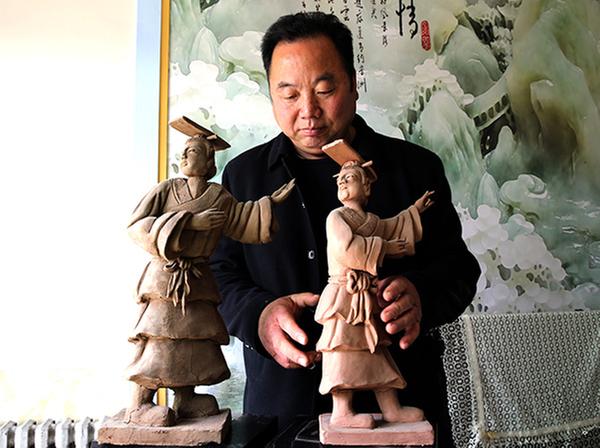5,000 years on, the Yellow Emperor still a unifying force
By Huo Yan and Li Yang | chinadaily.com.cn | Updated: 2017-04-03 08:28
 |
| Cao Shuquan with two Yellow Emperor figures he made from clay. [Photo by Huo Yan/China Daily] |
While the annual event is important in terms of ancestral worship, officials in Huangling also see it as an opportunity to build the county's image as the cradle of Chinese civilization, or the "spiritual home of ethnic Chinese people", and to boost the local tourism and cultural industries.
Tourism development is a key ingredient of plans to restructure the local economy, which currently relies heavily on coal mining, according to Meng Zhonghua, the county Party chief.
"The county's potential lies in tourism, hope lies in tourism, the answer to economic restructuring is in tourism," he said recently. "We need to promote the deep integration of culture and tourism to boost the industrialization and branding of Huangling."
Data from the county government show tourists visited Huangling 5.2 million times last year, up by 71 percent on 2011. Tourism revenue was 1.83 billion yuan ($265 million), an increase of 83 percent over the same period.
Growth of the tourism industry has seen the service sector's contribution to local GDP rise from 15.5 percent to 26.4 percent between 2011 and last year, the statistics show.
In addition to the Mausoleum of the Yellow Emperor, visitors are drawn by the county's many other historical attractions, such as its Qin Dynasty (221-206 BC) relics Qinzhidao; Zi'e Temple, which dates back to the Tang Dynasty (618-907); and Wan'an Zen Temple, which was built in the Song Dynasty (960-1279).
Huangling National Forest Park also attracts many people-the county is 76 percent forest, three times the national average-as does the local intangible cultural heritage, such as paper-cutting and decorative flour buns.
However, while visitor numbers have increased, the availability of tourism services like hotels and parking lots have failed to keep up. This is an issue officials are keen to fix.
"We'll pay special attention to deepening supply-side reform and boosting tourism growth," Gao Yong, the head of the county government, said recently, promising a review of services and support systems. "We'll provide what tourists need, and we'll correct the problems they find."
The county set creating a "holistic tourism destination" as a main task in its Government Work Report this year. Gao said the goal is to get more sightseers to stay for at least one night in Huangling, which is usually just a stop-off for those traveling between the historic cities of Xi'an, the provincial capital, and Yan'an, the birthplace of the revolution led by the Communist Party of China.
Backed by the Shaanxi government, county officials began work on the Yellow Emperor Cultural Park in 2011. The venue, which will have the mausoleum at its center, will cover 24 square kilometers and include an exhibition hall, cultural industry projects and developed tourism facilities, according to the plans. The opening is slated for 2030.
























